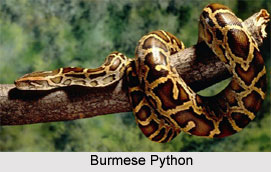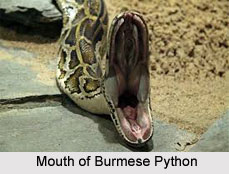 Burmese Python is an Indian Reptile that bears a scientific name "Python bivittatus" found in the sub tropical countries.
Burmese Python is an Indian Reptile that bears a scientific name "Python bivittatus" found in the sub tropical countries.
Category of Burmese Python
Burmese Python is one of the five largest species of snakes in the world, about the third-largest as measured either by length or weight.
Concentration of Burmese Python
Burmese Python is native to a large variation of tropic and subtropics areas of South and Southeast Asia. Until 2009, it was considered a subspecies of Python molurus, but now is recognized as belonging to a distinct species.
Habitat of Burmese Python
Burmese Python is often found near water and are sometimes semi-aquatic, but can also be found in trees. The wild individuals average 3.7 m long, but have been known to reach 5.74 m (18.8 ft).
Structure of Burmese Python
Burmese Pythons are dark-coloured snakes with many brown blotches bordered in black down the back. The perceived attractiveness of their skin pattern contributes to their popularity with both reptile keepers and the leather industry.
Pattern of Burmese Python
 The pattern of Burmese Python is similar in colour, but different in actual pattern from the African rock python (Python sebae), sometimes resulting in confusion of the two species outside their natural habitats.
The pattern of Burmese Python is similar in colour, but different in actual pattern from the African rock python (Python sebae), sometimes resulting in confusion of the two species outside their natural habitats.
Distinction of Burmese Python
The African Rock Python can generally be distinguished by its tighter pattern of markings, compared to the Burmese Python, which has bolder patterns, similar to those seen on a giraffe.
Size of Burmese Python
Burmese Pythons grow to 3.7 m on average, while specimens of more than 4 m (13 ft 1 in) are uncommon. This species is sexually dimorphic in size; females average only slightly longer, but are considerably heavier and bulkier than the males. In general, individuals over 5 m (16 ft 5 in) are rare.
Behaviour of Burmese Python
Burmese Pythons are mainly nocturnal rainforest dwellers. When young, they are equally at home on the ground and in trees, but as they gain girth, they tend to restrict most of their movements to the ground. They are also excellent swimmers, being able to stay submerged for up to half an hour. Burmese pythons spend the majority of their time hidden in the underbrush. In the northern parts of its range, the Indian python may brumate for some months during the cold season in a hollow tree, a hole in the riverbank, or under rocks. Brumation is biologically distinct from hibernation. While the behaviour has similar benefits, specifically to endure the winter without moving, it also involves preparation of both male and female reproductive organs for the upcoming breeding season.
Breeding of Burmese Python
Burmese Pythons breed in the early spring, with females laying clutches of
12-36 eggs in March or April. They remain with the eggs until they hatch, wrapping around them and twitching their muscles in such a way as to raise the ambient temperature around the eggs by several degrees. Once the hatchlings use their egg tooth to cut their way out of their eggs, no further maternal care is given. The newly hatched often remain inside their eggs until they are ready to complete their first shedding of skin, after which they hunt for their first meal.
Diet of Burmese Python
Burmese Python is carnivorous. Its diet consists primarily of appropriately sized birds and mammals. The snake uses its sharp rearward-pointing teeth to seize its prey, then wraps its body around the prey, at the same time contracting its muscles, killing the prey by constriction. It is often found near human habitation due to the presence of rats, mice, and other vermin as a food source.



















